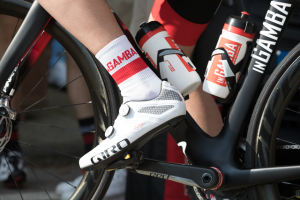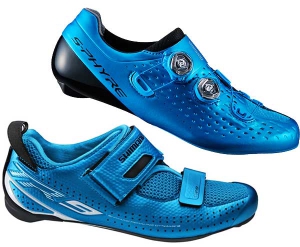As we’ve said before at Slowtwitch, road shoes can work great for triathlon, especially long-course. We just featured a new road shoe from Giro that can serve such a purpose, called the Imperial. It aims for high usability and comfort over shaving every last gram of weight.

As we mentioned in our intro to the Imperial, we wanted to dive a bit deeper into Giro’s design philosophy for cycling footwear, as they’re still a relatively new player in the game. They’ve offered tri-specific shoes in the past, but don’t have a current offering. We corresponded with Eric Horton, Director of Design at Giro, to find out what they think, and how they’re designing shoes for road and tri athletes.

Slowtwitch: How long has Giro been making shoes?
Eric Horton: We launched the Giro footwear line at Eurobike 2010, and product was available at retail in Spring of 2011.
ST: For people not familiar with Giro shoes in general, what are the biggest two or three things that differentiate them from other brands?
EH: From the beginning, we’ve talked about fit as the key differentiator versus a focus purely on stats. Comfort is essential to pedaling efficiency, performance, and the rider’s experience. When we presented the Giro footwear line to the media for the first time, we gave them a behind-the-scenes look at shoe making. We showed them “lasts” for instance –the three-dimensional foot form which defines the fit of the shoe. We talked about the benefits of properly supporting the arch with our adjustable supernatural fit system and why we will not build ergonomic “corrections” into our shoes but rather create a neutral platform that is easy for fit specialists to work with. The vast majority of riders can be comfortable with an ergonomically shaped last, a properly-supported arch, and an accurate cleat placement. Riders that have unique issues should seek the help of a trained cycling fit specialist.

ST: What is the Super Natural Fit footbed? Do you offer more than one shoe width?
EH: The SuperNatural Fit footbed is a very simple but highly-effective arch support system. It includes three levels of arch support that allow the user to choose the perfect level of support for their particular foot. All three supports are included with the system and they are easily swapped in a few seconds. We encourage the user to try the different supports on a short test ride to determine which feels most comfortable to them. You really can’t get a good feel for the right level of support by only trying shoes or footbeds on in the store. Side note: I find that my right foot prefers the high arch while my left foot is more comfortable with the medium arch. Our system allows for those types of differences without having to buy two different footbeds.
[Regarding width options,] in select models we offer an “HV” or High Volume fit. The philosophy behind HV is to accommodate wider feet and also those with greater girth. Simply put, our HV shoes have a size and a half more girth for the same length–in other words a 42.5 HV would have the same girth as a standard size 44.

ST: Where does the new Imperial fit in to the current lineup?
EH: It’s our new pro-level shoe with the Synchwire upper and dual BOA adjustment. The Imperial is built on our performance fit last (the same as the acclaimed Empire) and our new Synchwire composite upper construction offers a wide fit range. The upper is so supple and conforming, yet extremely supportive, right out of the box.

ST: How does the average cyclist decide between a shoe that uses the BOA system versus lace-up?
EH: That’s a tough one! Does the rider value precision over convenience? If the rider wants the ultimate in personalized fit, then nothing beats laces. But laces can be intimidating because it can take a little practice to get the fit just right, and it can certainly be inconvenient to stop to adjust your shoe laces. That said, it becomes habit pretty quickly and few riders ever have to stop for an adjustment once they’re familiar with laces. What we’ve tried to do with the Imperial’s BOA system is emulate the best attributes of laces but give the rider on-the-fly adjustability. You’ll notice that our system uses a traditionally shaped “U-throat” and that the dials and lace guides are in similar locations as you find on a lace-up shoe. Our testing proved to us that this design gives the athlete the best comfort and adjustability and feels the most similar to laces.

ST: What does it mean when you say that the Imperial “is not a quiver shoe”?
EH: When we presented the Prolight Techlace a couple of seasons ago, our aim was to make the lightest production shoe possible. We made material choices and decisions on specification based on low weight more than everyday functionality. We achieved something that got the editors excited and we were happy with the results, but we sacrificed some practicality to shave a few grams. The Imperial by contrast is more robust where it counts, and we’ve added back in meaningful features like replaceable walking pads. The Imperial is certainly ultralight at just 215 g for a 42.5 shoe, but we’ve learned where to make spec choices that have meaningful improvements in the long-term durability and serviceability of the shoes.

ST: We’ve noticed that, especially for Ironman-distance racing, a good number of triathletes prefer to use a road-style shoe. This is typically because they value the often-improved comfort and secure closure system of a road shoe compared to a short-course tri shoe, and are willing to take the time in transition to put them on (vs pre-clipping a tri shoe and hopping on their bike. What’s your take on the situation?
EH: If your feet are not comfortable and supported properly, a couple of saved seconds in the transition zone become meaningless pretty quickly.

ST: There’s been a lot of debate about sole stiffness, and how to best design a sole. One side seems to favor increased stiffness as always being a benefit, while the other side says that some amount of flex – perhaps in specific places – makes for a more efficient or more comfortable shoe. What is Giro’s position?
EH: This one is anecdotal and very personal, not scientific. I find that the stiffest sole possible, combined with a properly supported arch gives me the most on bike comfort. A flexy sole causes my foot unwanted pressure in the arch area. If the arch is not supported properly, the foot flexes inside the shoe causing friction and strain, and ultimately fatigue.

ST: What types of advancements do you think we’ll see in cycling shoes in the next 10 years? Have we maxed out on weight reduction? Will it be some type of electronics or other ‘smart’ tech?
EH: Material science and ergonomic research continue to evolve, so no, I don’t think we’ve hit any type of end-of-the-road in cycling shoe advancements. Certainly, integrating sensors to measure power/side-to-side bias can be helpful to enthusiast-level riders and pro athletes as well. The whole pedal/cleat interface feels like it is ripe for an overhaul…

ST: For someone just getting into cycling (and likely on a budget), what should they look for in a cycling shoe for road or triathlon?
EH: The three C’s. Comfort, comfort, and comfort. Nothing else matters if your feet aren’t comfortable.
Giro.com



